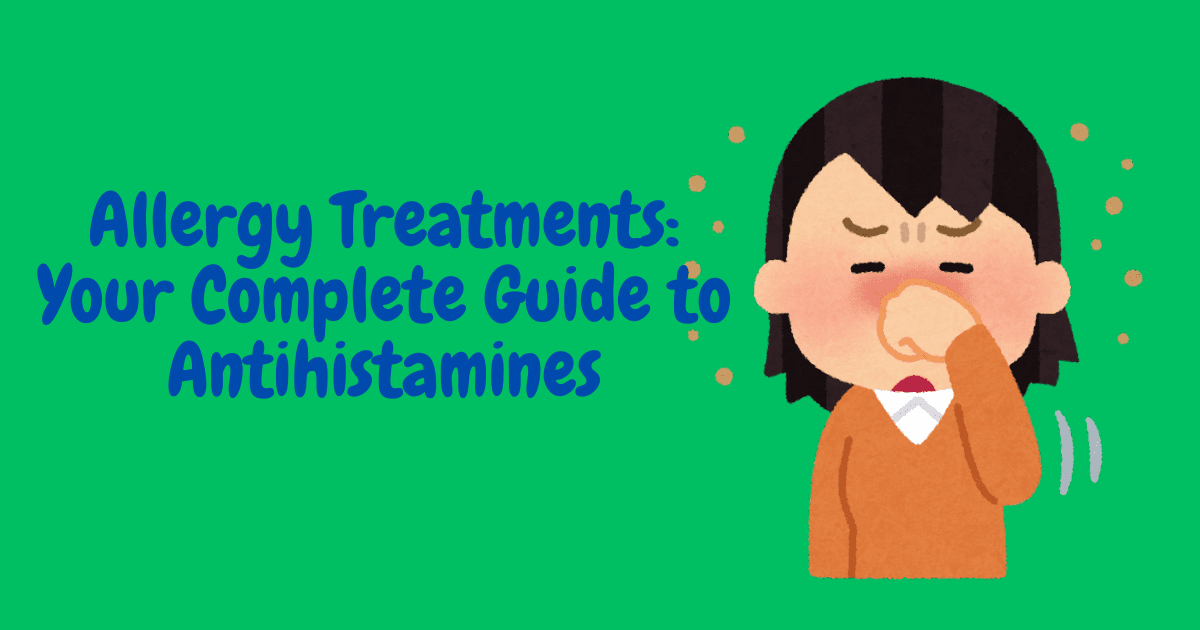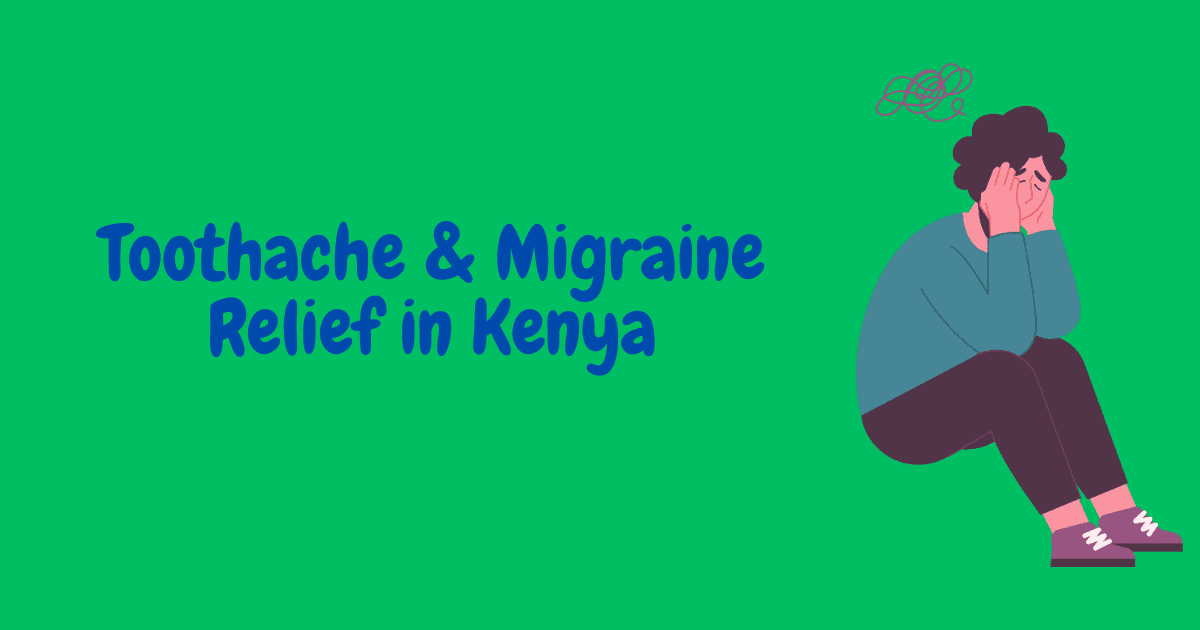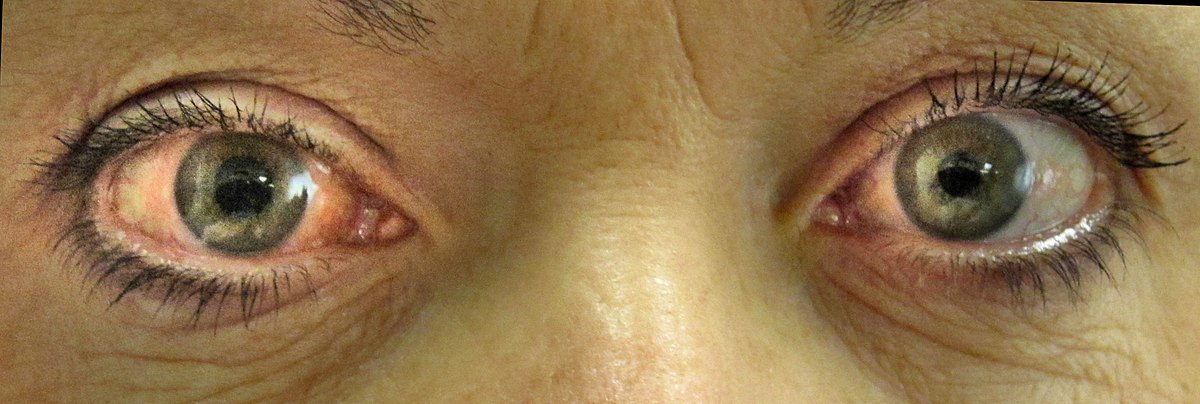If you’re constantly sneezing, rubbing itchy eyes, or dealing with mysterious skin rashes, you’re not alone. Allergies are becoming increasingly common across Kenya, affecting people of all ages from Nairobi’s dusty streets to the humid coastal regions of Mombasa. Whether your symptoms are triggered by pollen during flowering season, dust mites thriving in Kenya’s varied climate, certain foods, or insect stings, finding effective relief is essential for maintaining your quality of life.
This comprehensive guide explains everything you need to know about antihistamines, the primary medication class for managing allergies in Kenya. We’ll cover how they work, which brands are available locally, their side effects, and most importantly, how to choose the right one for your specific symptoms and lifestyle.
The Rise of Allergies in Kenya: Understanding the Problem
Why Are Allergies Becoming More Common?
Allergic conditions, including allergic rhinitis (hay fever), skin rashes (urticaria), and contact dermatitis, are on the rise in Kenya. Several factors contribute to this increase:
Urban Air Quality: Cities like Nairobi and Mombasa face significant air pollution from traffic, industrial emissions, and construction dust. These irritants can trigger or worsen allergic responses, especially respiratory allergies.
Climate Variability: Kenya’s diverse climate zones, from humid coastal areas to the dry highlands, create different allergy challenges. Dust mites thrive in humid environments, while dry, dusty conditions in arid regions irritate airways and trigger allergic reactions.
Changing Lifestyles: Increased exposure to processed foods, new chemicals in household products, and lifestyle changes have introduced novel allergens that our bodies may react to.
Increased Awareness: More Kenyans are recognizing and seeking treatment for allergy symptoms rather than dismissing them as just “a cold” or “sensitive skin.”
Common Allergy Triggers in Kenya
Understanding what triggers your allergies is the first step toward managing them:
Pollen: Seasonal allergies peak during flowering periods, particularly during the rainy seasons when plants are actively growing and releasing pollen.
Dust and Dust Mites: These microscopic creatures live in bedding, upholstered furniture, and carpets. They’re particularly problematic in humid coastal regions.
Food Allergies: Common culprits include peanuts, shellfish, eggs, milk, and certain fruits.
Insect Stings: Bee, wasp, and ant stings can trigger severe allergic reactions in sensitive individuals.
Mold and Mildew: Thrive in Kenya’s humid areas, especially during rainy seasons.
Pet Dander: Cats and dogs shed skin cells that trigger allergic reactions in many people.
The Importance of Quick Relief
While avoiding your allergy triggers is the ideal strategy, it’s not always possible. You can’t avoid going outside during pollen season or eliminate every dust mite from your home. This is why antihistamines have become an essential part of the Kenyan medicine cabinet, offering fast, effective relief when allergy symptoms strike.
What Are Antihistamines? Understanding How They Work
To understand how antihistamines provide relief, you need to understand what happens during an allergic reaction.
The Allergic Response Explained
When your body encounters an allergen like pollen, pet dander, or certain foods, your immune system identifies it as a threat (even though it’s harmless). In response, your immune system releases a chemical called histamine. This is your body’s defense mechanism, but it causes the uncomfortable symptoms you experience:
Itching and Swelling: Histamine causes blood vessels to leak fluid into surrounding tissues, leading to swelling and that maddening itch.
Increased Mucus Production: The flood of histamine triggers your nose and airways to produce extra mucus, causing that constant runny nose and post-nasal drip.
Airway Constriction: In severe cases, histamine can cause airways to narrow, leading to wheezing and difficulty breathing.
Skin Reactions: Histamine released in the skin causes hives, redness, and intense itching.
How Antihistamines Block These Symptoms
Antihistamines work by blocking histamine from attaching to its target sites, called H1 receptors, throughout your body. Think of it like blocking a key from fitting into a lock. By preventing histamine from binding to these receptors, antihistamines effectively stop or significantly reduce allergic symptoms before they can fully develop.
The key to maximum effectiveness is taking antihistamines at the first sign of symptoms or, if you know you’ll be exposed to an allergen, taking them preventatively.
Common Antihistamines Available in Kenya
Antihistamines are classified into generations based on their development timeline and, more importantly, their side effect profiles, particularly drowsiness. Understanding these differences helps you choose the right medication for your situation.
Second Generation: The Non-Drowsy Champions
These newer antihistamines are designed to provide effective allergy relief without the sedating effects of older options. They’re ideal for daytime use when you need to remain alert and productive.
Cetirizine (Zyrtec, Rhizin, Cetrizet)
Cetirizine is one of the most popular antihistamines in Kenya, and for good reason. It works quickly, typically within 30 to 60 minutes, and provides 24-hour relief with a single daily dose. While marketed as non-drowsy, some people do experience mild drowsiness, though far less than with first-generation antihistamines.
Best for: General allergy symptoms including sneezing, runny nose, itchy eyes, and hives. Particularly effective for skin allergies.
Dosage: Adults and children over 6 years typically take 10mg once daily. It can be taken with or without food.
Loratadine (Clarityne, Lorfast)
Loratadine is another excellent second-generation option with an even lower risk of drowsiness than cetirizine. It’s a favorite among Kenyans who need reliable daytime allergy relief without any sedative effects.
Best for: Seasonal allergies (hay fever), dust allergies, and mild to moderate allergic reactions. Ideal for people who are particularly sensitive to drowsiness.
Dosage: Adults and children over 6 years take 10mg once daily. Works best when taken consistently during allergy season rather than just when symptoms occur.
Third Generation: The Latest Innovation
Fexofenadine (Telfast, Fenofex)
Fexofenadine represents the next evolution in antihistamine development. It offers powerful allergy relief with minimal side effects, including virtually no drowsiness. It’s a metabolite of an older antihistamine, refined to maximize benefits while minimizing drawbacks.
Best for: People who experienced drowsiness even with second-generation options, or those needing very reliable daytime alertness (drivers, machinery operators, students).
Dosage: Adults typically take 120mg or 180mg once daily, depending on severity of symptoms.
First Generation: The Sedating but Powerful Options
While newer antihistamines have largely replaced these older medications for routine use, first-generation antihistamines still have important roles in allergy management.
Chlorpheniramine (Piriton, Actin, Allergex)
Chlorpheniramine is highly effective for severe allergic reactions, particularly intense itching and hives. However, it causes significant drowsiness, which limits its use to nighttime or situations where sedation is acceptable or even desirable.
Best for: Severe itching, hives, or allergic reactions at night. The sedative effect can actually help you sleep through uncomfortable symptoms.
Dosage: Adults typically take 4mg every 4 to 6 hours, not exceeding 24mg daily. Because of the drowsiness, many people prefer taking a larger dose at bedtime.
Important warning: Never drive, operate machinery, or perform tasks requiring alertness after taking chlorpheniramine.
Stugeron (Cinnarizine): A Special Case
Stugeron is a brand name that’s well-known across Kenya, but it’s often misunderstood. While Stugeron contains an antihistamine (cinnarizine), it’s primarily used for specific conditions rather than typical allergies.
Primary Uses of Stugeron
Motion Sickness
This is Stugeron’s most common application in Kenya. If you suffer from nausea, dizziness, and vomiting during matatu rides, long bus journeys, or boat trips, Stugeron is highly effective. It works by blocking signals to the balance center in your brain, preventing the disorientation that causes motion sickness.
Dosage for travel: Take one 25mg tablet two hours before travel, then one tablet every 8 hours during the journey if needed.
Vestibular Disorders and Vertigo
Stugeron is often prescribed by doctors for inner ear conditions that cause severe dizziness (vertigo). If the room spins when you move your head, or you experience persistent dizziness, a doctor might prescribe Stugeron for longer-term use.
The Allergy Connection
Because cinnarizine is a first-generation antihistamine with H1-blocking properties, it can provide allergy relief. However, due to its strong sedative effects, it’s rarely the first choice for typical allergy symptoms like hay fever or skin rashes. You’d only use Stugeron for allergies if you specifically need strong sedation along with antihistamine action, or if you’re already taking it for motion sickness or vertigo.
Side Effects and Safe Use of Antihistamines
Understanding potential side effects ensures you use antihistamines safely and choose the right one for your circumstances.
First-Generation Antihistamines: What to Expect
Drowsiness and Sedation
This is the defining characteristic of first-generation antihistamines. The drowsiness can be profound, similar to taking a sleeping pill. This effect lasts for several hours and significantly impairs your ability to drive, work, or perform tasks requiring concentration.
Never drive or operate machinery after taking chlorpheniramine or cinnarizine. Plan your day accordingly if you need to take these medications.
Anticholinergic Effects
These antihistamines can cause:
- Dry mouth and throat
- Blurred vision
- Constipation
- Difficulty urinating (particularly problematic for older men)
- Confusion in elderly people
Alcohol Interaction
Combining alcohol with first-generation antihistamines intensifies the sedative effects dramatically and dangerously. The combination severely impairs judgment, coordination, and reaction time. Avoid alcohol entirely when taking these medications.
Second and Third Generation: Generally Well Tolerated
Minimal Drowsiness
While marketed as non-drowsy, individual responses vary. Most people experience no drowsiness at all with loratadine or fexofenadine. Cetirizine occasionally causes mild drowsiness in some users.
Tip: Take your first dose of any new antihistamine when you don’t have important commitments, so you can gauge how your body responds.
Mild Side Effects
The most common side effects are minor:
- Slight headache
- Dry mouth
- Mild stomach upset
These effects are usually temporary and resolve as your body adjusts to the medication.
Drug Interactions
While generally safe, inform your pharmacist if you’re taking other medications. Some antibiotics and antifungal medications can interact with certain antihistamines.
General Safety Guidelines
Follow Dosage Instructions
More is not better with antihistamines. Taking extra doses won’t provide faster or better relief and increases the risk of side effects. Stick to the recommended dosage on the package or as directed by your healthcare provider.
Don’t Mix Antihistamines
Taking multiple antihistamine products simultaneously (like Piriton and Zyrtec together) doesn’t enhance effectiveness but does increase side effect risks. Choose one appropriate antihistamine and use it consistently.
Special Populations
Pregnancy and breastfeeding: Some antihistamines are considered safer than others during pregnancy. Always consult your doctor before taking any antihistamine if you’re pregnant or breastfeeding.
Elderly people: First-generation antihistamines can cause confusion and increase fall risk in older adults. Second-generation options are generally preferred.
Children: Many antihistamines are available in child-appropriate doses, but always check the label for age restrictions and proper dosing.
People with certain conditions: Those with glaucoma, enlarged prostate, or urinary retention should avoid first-generation antihistamines or use them only under medical supervision.
Frequently Asked Questions
What’s the difference between drowsy and non-drowsy antihistamines?
First-generation antihistamines like chlorpheniramine cross into the brain easily, affecting areas that control wakefulness and causing significant drowsiness. Second and third-generation antihistamines like cetirizine, loratadine, and fexofenadine are designed to stay outside the brain, providing allergy relief without sedation. Think of it as a targeted approach that affects only the areas where histamine causes allergy symptoms.
Can I take antihistamines every day?
Yes, second and third-generation antihistamines are safe for daily use during allergy season or year-round if you have persistent allergies. Many people take them continuously for months without problems. However, if you find you need daily antihistamines for extended periods, consult a doctor to identify your triggers and explore long-term management strategies.
How long does it take for antihistamines to work?
Most antihistamines start working within 30 to 60 minutes, with peak effects at 1 to 2 hours. For best results with seasonal allergies, take your antihistamine before exposure to triggers or at the same time each day to maintain consistent protection.
Why isn’t my antihistamine working anymore?
If your antihistamine stops being effective, several factors could be responsible. You might be experiencing a different type of reaction (like an infection rather than allergies), the allergen exposure might be overwhelming, or in rare cases, your body might have adapted. Try switching to a different antihistamine or see a doctor for evaluation.
Can I take antihistamines with other medications?
Generally yes, but some interactions exist. Antihistamines can interact with certain antibiotics, antifungals, and medications for heart rhythm problems. Always inform your pharmacist about all medications you’re taking, including herbal supplements.
Is it safe to drink alcohol while taking antihistamines?
This depends on the generation. Never drink alcohol with first-generation antihistamines like chlorpheniramine or cinnarizine, as the combination dangerously amplifies sedation. With second and third-generation antihistamines, moderate alcohol consumption is generally safer, but it’s still best to minimize alcohol as it can enhance any drowsiness effects.
What should I do if I accidentally take too much antihistamine?
Contact a healthcare provider immediately if you or someone else takes an excessive dose. Symptoms of overdose include extreme drowsiness, confusion, rapid heartbeat, seizures (in severe cases), or paradoxically, restlessness and agitation, especially in children. Keep the medication package to show medical staff exactly what was taken.
Can antihistamines help with food allergies?
Antihistamines can help with mild symptoms of food allergies like itching, hives, or mild swelling. However, they cannot prevent or treat severe allergic reactions (anaphylaxis). If you have known severe food allergies, you need an EpiPen (epinephrine auto-injector) and should see an allergist for proper management.
Why do I still have a runny nose even after taking antihistamines?
If your runny nose persists despite antihistamines, you might have a non-allergic condition like a sinus infection, viral cold, or non-allergic rhinitis. Antihistamines only work for histamine-mediated allergic reactions. See a doctor if symptoms persist beyond a week or worsen.
Should I take antihistamines before or after meals?
Most antihistamines can be taken with or without food. Take them with food if you experience stomach upset. For best consistency, take them at the same time each day, whether that’s with breakfast, lunch, or dinner.
Can children take adult antihistamines?
No, children should take formulations specifically designed for their age and weight. Adult doses can be dangerous for children. Many brands offer pediatric versions with appropriate dosing. Always check the label for age restrictions and consult a pharmacist if unsure.
What’s better for allergies: Zyrtec or Clarityne?
Both are excellent non-drowsy antihistamines, and choice often comes down to personal response. Cetirizine (Zyrtec) works slightly faster and may be more effective for skin allergies, but some people find it causes mild drowsiness. Loratadine (Clarityne) has virtually no drowsiness but might take slightly longer to reach peak effect. Try one for a week; if it doesn’t work well, switch to the other.
Choosing the Right Antihistamine for Your Symptoms
Selecting the appropriate allergy medication depends on understanding your symptoms, your daily schedule, and how different antihistamines will affect you.
For Daytime Relief: Stay Alert and Symptom-Free
If you’re dealing with sneezing, runny nose, itchy eyes, or mild hives during the day and need to remain productive at work, school, or while driving, choose a non-drowsy second or third-generation antihistamine.
Best choices: Loratadine (Clarityne, Lorfast) or Fexofenadine (Telfast, Fenofex) offer the lowest risk of drowsiness. Cetirizine (Zyrtec, Rhizin) is also effective, though it occasionally causes mild drowsiness in some people.
Take these medications in the morning with breakfast for all-day protection, or 30 minutes before expected allergen exposure.
For Nighttime Symptoms: Sleep Through the Discomfort
If severe itching, hives, or allergy symptoms are keeping you awake at night, a sedating first-generation antihistamine can be your ally. The drowsiness that makes these medications unsuitable for daytime use actually becomes a benefit, helping you sleep while providing powerful symptom relief.
Best choice: Chlorpheniramine (Piriton, Actin, Allergex) taken 30 minutes before bed provides strong antihistamine action plus sedation for restful sleep.
For Travel Sickness, Dizziness, and Vertigo
If your primary concern is motion sickness during travel or you’re experiencing vertigo from an inner ear condition, standard allergy antihistamines won’t be as effective.
Best choice: Stugeron (Cinnarizine) is specifically designed for these vestibular issues. Take it 2 hours before travel for motion sickness prevention, or as prescribed by your doctor for vertigo treatment.
For Severe Allergic Reactions
If you experience severe allergic reactions with intense itching, widespread hives, or significant swelling, you need powerful, fast-acting relief.
Immediate action: Take a first-generation antihistamine like chlorpheniramine for rapid symptom control. However, if you experience difficulty breathing, throat swelling, or dizziness, this is a medical emergency. Seek immediate hospital care, as you may need epinephrine (adrenaline) injection.
For Skin Allergies and Rashes
Antihistamines are particularly effective for allergic skin conditions like hives (urticaria), allergic rashes, and itching from insect bites.
Best choice: Cetirizine (Zyrtec) is often considered the most effective antihistamine for skin-related allergies. Take 10mg daily until symptoms resolve.
When to See a Doctor About Your Allergies
While over-the-counter antihistamines effectively manage most allergy symptoms, certain situations require professional medical attention.
Seek Medical Care If:
Symptoms Don’t Improve: If you’ve been taking antihistamines correctly for a week and symptoms persist or worsen, you need medical evaluation. This could indicate a non-allergic condition, a more severe allergic response, or the need for prescription-strength treatments.
Breathing Difficulties: Wheezing, chest tightness, or shortness of breath accompanying allergy symptoms suggests asthma or a severe allergic reaction requiring immediate medical attention.
Severe Reactions: Rapid swelling of the face, lips, tongue, or throat, difficulty swallowing, dizziness, or a sudden rash covering large areas of your body are signs of anaphylaxis, a life-threatening emergency.
Chronic Symptoms: If you need antihistamines daily for months with no clear trigger or improvement, an allergist can perform testing to identify specific allergens and develop a comprehensive management plan, potentially including immunotherapy (allergy shots).
Side Effects: If antihistamines cause severe side effects or you have underlying health conditions like glaucoma, prostate problems, or heart rhythm disorders, a doctor can recommend safer alternatives.
Your Path to Effective Allergy Management
Living with allergies in Kenya doesn’t mean accepting constant discomfort. The range of antihistamines available in local pharmacies provides effective options for nearly every allergy situation, from seasonal hay fever to severe hives.
The key to successful allergy management lies in understanding your symptoms, choosing the appropriate antihistamine for your situation, and using it correctly. Second and third-generation antihistamines like loratadine, cetirizine, and fexofenadine offer excellent daytime relief without drowsiness, allowing you to maintain your normal activities. First-generation options like chlorpheniramine remain valuable for nighttime use or when powerful sedation is needed alongside allergy relief. For motion sickness and vertigo, Stugeron provides specialized care that standard allergy medications cannot match.
Remember that while antihistamines provide symptom relief, identifying and avoiding your allergy triggers offers the most effective long-term solution. Keep track of when your symptoms occur and what you were exposed to beforehand. This information helps you anticipate problems and take preventative antihistamines before symptoms start.
Your local pharmacist is an invaluable resource for selecting the right antihistamine and ensuring safe use, especially if you’re taking other medications or have underlying health conditions. Don’t hesitate to ask questions about timing, dosing, and potential interactions.
For persistent, severe, or worsening allergy symptoms, consulting with a doctor or allergist opens up additional treatment options, including prescription-strength antihistamines, nasal corticosteroids, or immunotherapy for long-term relief. Your allergies are manageable, and with the right approach, you can enjoy life in Kenya without constant sneezing, itching, and discomfort.












Leave a Reply